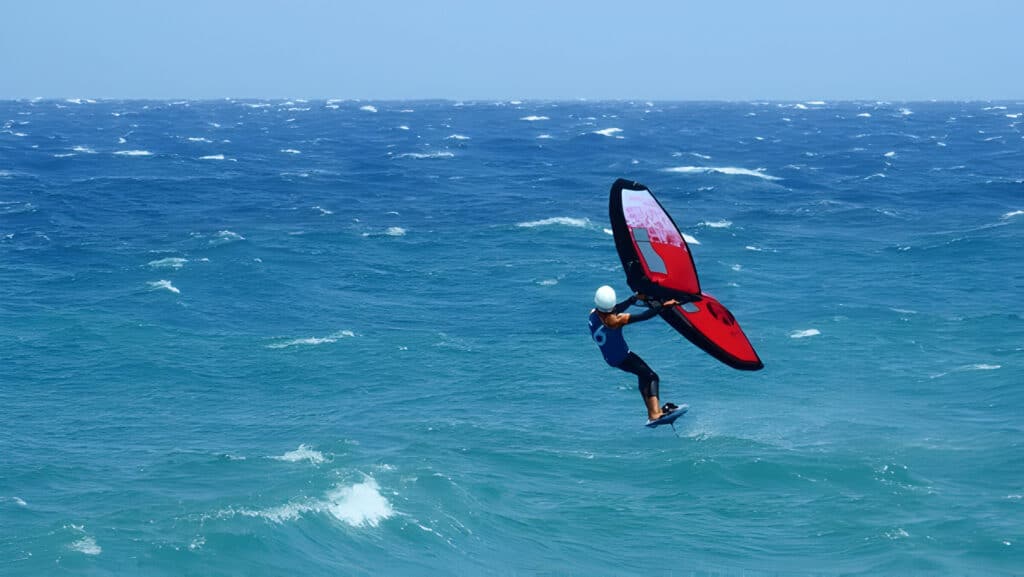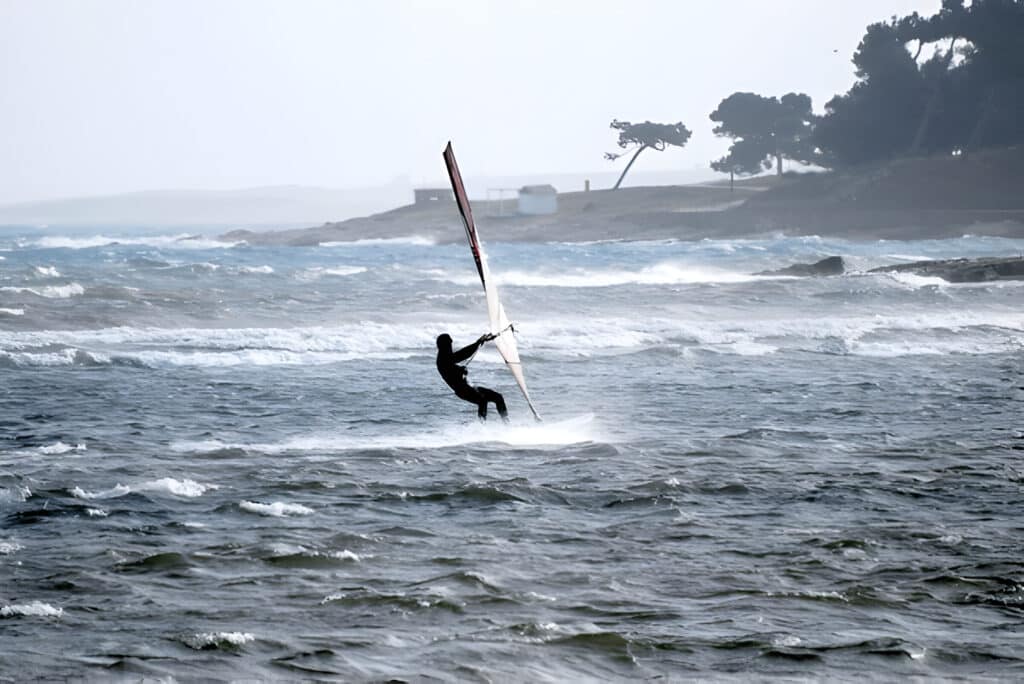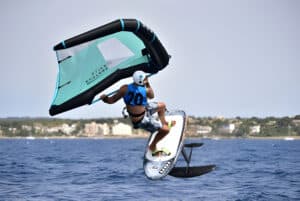Wing foiling, like any water sport, carries inherent risks but is not inherently dangerous when proper safety precautions are taken. The level of danger largely depends on the rider’s experience, weather conditions, and adherence to safety guidelines.
This article will explore the potential risks associated with wing foiling, safety measures to mitigate these risks, and tips for enjoying this exhilarating sport responsibly. We’ll also compare wing foiling’s safety profile to other water

Risks in Wing Foiling
Equipment-Related Risks
Wing foiling involves specialized equipment, and each piece carries its own potential dangers. The foil board, with its sharp hydrofoil, presents a significant risk of injury if mishandled. Impact injuries can occur when riders collide with the board or foil during falls.
The wing itself, while less dangerous than the board, can cause injuries if not controlled properly. Wrist straps and foot straps, while providing stability, may lead to strain injuries if improperly adjusted or used. The wing leash, essential for safety, can become entangled, potentially leading to dangerous situations.
Environmental Risks
Wing foiling is heavily dependent on environmental conditions, which can change rapidly. Sudden shifts in wind or water conditions can catch even experienced riders off guard. Surf waves and changeable conditions require constant vigilance and adaptability.
Water temperature is another critical factor. Extended exposure to cold water can lead to hypothermia, particularly in extreme conditions. Conversely, warm waters may harbor marine life that poses risks to riders.
Weather conditions, including storms and lightning, present significant dangers. Riders must be aware of forecasts and prepared to exit the water quickly if conditions deteriorate.
Collision with Other Watercraft or Objects
The risk of collision with other watercraft or objects is a serious concern in wing foiling. As the sport gains popularity, crowded waters increase the likelihood of accidents. Collisions can occur with other wing foilers, surfers, or motorized vessels, potentially resulting in severe injuries.
Underwater obstacles, such as rocks or reefs, pose additional risks, especially in unfamiliar locations. Riders must be aware of their surroundings and maintain safe distances from potential hazards.
Skill Level and Physical Fitness Risks
Beginners are at higher risk of injury due to lack of control and experience. Even at an intermediate level, wingsurfers may overestimate their abilities, leading to accidents.
Physical fitness is another important factor. Wing foiling requires strength, endurance, and balance. Overuse injuries, such as elbow tendonitis or shoulder injuries.

Common Injuries in Wing Foiling
Impact Injuries
Impact injuries are among the most frequent injury types in wing foiling. These typically occur when a rider collides with their equipment or the water surface. The severity of injury can vary depending on factors such as water conditions, speed, and the use of protective gear. Common impact injuries include:
- Bruises and contusions, particularly to the ribs and legs
- Cuts and lacerations from contact with sharp edges of the board or foil
- Head injuries, which can be mitigated by wearing a helmet
Strain Injuries
Overuse injuries and strains are typical injuries that wing foilers may experience, especially as they progress in skill levels and participate in longer sessions or competitions. These injuries often result from repetitive motions and can affect various parts of the body:
- Shoulder injuries from repetitive wing handling and maneuvering
- Elbow tendonitis or “wing foiler’s elbow,” similar to tennis elbow
- Lower back strain from maintaining posture and balance on the board
Using proper technique and gradually increasing session durations can help prevent strain injuries. For those experiencing elbow tendon issues, wearing an elbow brace during sessions may provide relief.
Foot and Ankle Injuries
The use of foot straps on foil boards can lead to specific injury situations involving the feet and ankles:
- Ankle sprains or twists when entering or exiting foot straps
- Abrasions or blisters from prolonged contact with straps
- Potential fractures if the foot becomes trapped during a fall
Proper adjustment of foot straps and using protective neoprene boots can reduce the risk of these injuries.
Environmental-Related Injuries
Wing foiling exposes riders to various environmental conditions that can lead to injuries:
- Sunburn and heat-related illnesses, particularly during long sessions in warm climates
- Hypothermia in cold water conditions, especially if proper wetsuit protection is not used
- Eye injuries from sun glare or water spray, which can be prevented with appropriate eyewear
Awareness of weather conditions and water temperature, along with the use of suitable protective equipment, is crucial in

Safety Measures
Proper Training
Beginners should seek instruction from an experienced instructor to learn the fundamentals of wing control, foil board handling, and safety protocols. Training sessions should cover various skill levels, from basic stance and launching techniques to advanced maneuvers in changeable conditions. Instructors can provide valuable personal experience and insight into injury prevention, helping newcomers develop a solid foundation for safe wing foiling practices.
Use of Safety Gear
- An impact vest is a critical piece of protective equipment, offering cushioning against falls and collisions.
- Helmets are recommended, especially for beginners or those attempting new tricks.
- A wing leash prevents the wing from flying away in strong winds, while a board leash keeps the foil board within reach.
- Wrist straps can help maintain control of the wing in challenging conditions.
- For colder environments, wetsuits protect against low water temperatures, reducing the risk of hypothermia.
Checking Wind and Water Conditions
Wind speed and direction significantly impact performance and safety. Wing foilers should check weather forecasts and use wind meters to ensure conditions are within their skill level.
Water conditions, including wave height and currents, also play a crucial role. Beginners should start in calm, flat water before progressing to surf waves.
Regularly Inspecting and Maintaining All Equipment
Before each session, inspect the wing for tears or damage, ensuring all straps and connections are secure. Check the foil board and foil for any signs of wear, loose screws, or cracks. Pay special attention to foot straps and mast connections. Rinse equipment with fresh water after use to prevent salt corrosion.
Adhering to a maintenance schedule and replacing worn parts promptly can significantly reduce the risk of equipment-related injuries.
Using a Buddy System and Having a Rescue Plan
Implementing a buddy system enhances safety by ensuring someone is always watching out for potential dangers.
Conclusion
Wing foiling, while exhilarating, does come with inherent risks. From equipment-related hazards to environmental challenges and potential collisions, the sport demands respect and caution. However, by understanding these risks, maintaining proper skill levels, and implementing crucial safety measures, enthusiasts can significantly mitigate dangers. Proper training, use of safety gear, careful assessment of wind and water conditions, regular equipment maintenance, and adopting a buddy system are all essential steps in ensuring a safer wing foiling experience.
While injuries can occur, being prepared and vigilant can help minimize their likelihood and severity. Ultimately, wing foiling’s risks can be managed, allowing riders to safely enjoy this thrilling water sport.


